The Scorpion Metes Out Justice With His Balance
by John P. Pratt
4 Feb 2016 (1 Light)
©2016 by John P. Pratt. All rights Reserved.
Index,
Home
A restoration of the constellations of Scorpius and Libra is proposed in which the Scorpion holds the Balance.
Recent articles have attempted to restore some of the constellation figures to their original form, hopefully to that revealed to the prophet Enoch long before the ancient Greeks who are our principal source of knowledge of the figures.[1] The key to restoring the originals was the discovery that the stars listed in the ancient Greek astronomer Ptolemy's star catalog which are identified as stars between constellations are often stars which were formerly included in the constellations but had been removed by an astronomer who felt he could draw the figure better.[2] This article discusses a proposed restoration of the adjacent zodiac constellations of the Scorpion (Scorpius) and the Balance (Libra) to a more ancient form, which is achieved by utilizing those formerly deleted stars.
1. The Balance
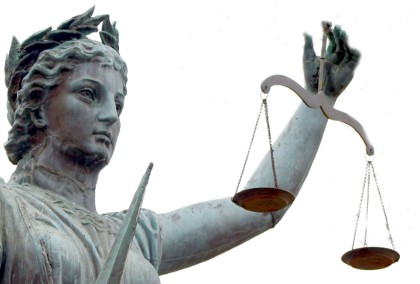 |
Justice holding the Balance
The constellation of the Balance (or Scales) is the second figure of the zodiac circle of twelve constellations when reckoned on the permanent basis of beginning with the Maiden (Virgo) and ending with the Lion (Leo). The name Libra means "weight" in Latin, referring to the weights used to balance the scales, especially to weigh out money before coins were invented. Hence the word "weight" became synonymous with "money", leading to the word "pound" in English referring to both a unit of weight and a unit of British currency. In case it ever seemed strange that the abbreviation for pound of weight is "lb" and a pound of money is "£" it is because "lb" is really an abbreviation for "libra", the origin of both concepts.
The Balance is usually believed to be a constellation invented by the Romans because it was apparently not known to the Greeks who preceded them. In its place in front of the Scorpion the Greeks saw only the great claws of the Scorpion. One big clue that they had known earlier that something else was there was the fact that they referred to the Claws as a separate constellation from the Scorpion. While the constellation of the Balance was unknown to Aratus and Greeks later than 350 BC, it was apparently known to Homer in about 850 BC. He wrote, "The Eternal Father hung his golden scales aloft."[3] Many ancient references to the Balance refer to them as being "golden" and they are colored yellow in my illustrations.
Additional research shows that in fact the Balance is an ancient constellation known much earlier. Manetho, writing during the 3rd century BC, is one of our principal sources for our knowledge of ancient Egypt. He claimed that the Egyptians invented the constellation of the Balance.[4] It is shown in several Egyptian temples, such as the planisphere at the temple of Hathor at Dendera, Egypt and also the temple of Khnum at Esna, Egypt. Both temples are believed to have been constructed one or two centuries BC, but the zodiac of Dendera can be dated to many centuries earlier.[5] That is, the zodiac drawing was apparently copied from a much earlier star map.
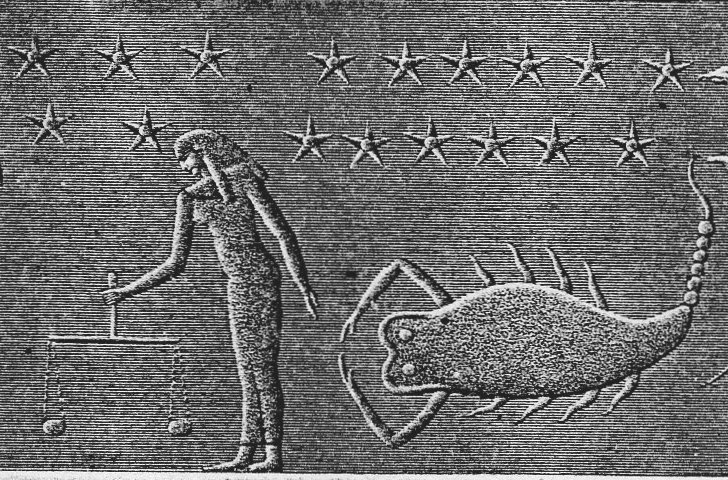 |
Fig. 1. The Balance and Scorpion in the Esna temple
Figure 1 shows an engraving of both the Scorpion and the Balance on the ceiling of the portico of the temple at Esna. It was carefully copied by the savants of Napoleon and published in 1820. This illustration was photocopied by the author from the original volume found at the University of Utah.[6] The quality of this image far exceeds any others found in my search for online images, so my entire collection from Esna will soon be added to my website.
The constellation of the Balance was also known to the ancient Persians. Figure 2 shows an illustration from a 1475 edition of the works of Albumazar based on the ancient Persian description of the constellation.[7] Note that both of these figures show a hand-held balance with a solid handle. One secular scholar notes that "the Persian sphere shows a human figure lifting the Scales in one hand and grasping a lamb in the other."[8]
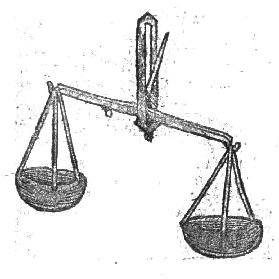 |
Fig. 2. The Persian Balance from Albumazar's description
So the question is how to restore the constellation of the Balance which is entirely missing from the Greek descriptions. As stated above, the big clue is to use the stars listed by Ptolemy as nearby the constellations. There are only three stars listed as near the Scorpion and all are by the stinger at the other end, so the restoration is accomplished entirely by using the nine stars listed as near the Claws. The Balance is either between the claws or in the area the Greek constellation of the Claws occupied.
This method yields results good enough to provide the confidence to publish this paper. The most easily recognized part of the constellation of the Balance is formed by 4 stars roughly in a square shape. Two are bright and two dimmer. The main question is what are the other stars and how is the figure shaped. Of the nine extraneous stars listed, three are between the Claws and six outside of them. If the three between the claws are added to the four that are almost certainly in the Balance, they form a figure almost identical to an ancient hand balance scale as we saw in Figures 1 and 2. Figure 3 shows the proposed restoration of the Balance, with the three restored stars indicated in the handle. Note that all three fall almost exactly along the ecliptic, which is the apparent path of the sun and planets through the heavens. The angle of the handle to the beam indicates that the Balance has one tray lower than the other as often shown in ancient drawings, such as that of Albumazar shown in Figure 2. In fact, even the lengths of the suspension straps, sizes and shapes of trays are very similar. When the proposed restoration figure was drawn, all of those details were dictated by the star positions.
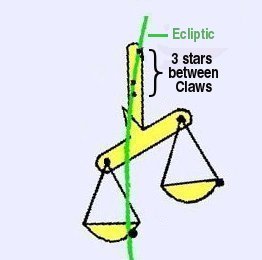 |
Fig. 3. Proposed restoration
of the Balance
The ancient star names also signify that the two bright stars do indeed form the trays of the Balance as shown in the proposed restoration. The old Arabic names refer to those two stars as the "trays". Scholars believe they got those names from the Romans, but to me that appears to be an assumption because all of their later names came from Greek, in particular from Ptolemy's work. In any case, it shows that those two stars represent the trays as in the proposed restoration presented here. The two Arabic names usually given in modern lists for these stars mean Northern Claw and Southern Claw, but these were merely later Arab translations of Ptolemy's designations.[9]
This discovery seems important enough to assign new names to these two bright stars. In the Arabic both stars were referred to as trays, but the brighter star (on the ecliptic) is also called "the Weight", most likely referring to it being the lower of the two trays. In my future work, the ecliptic tray star, Alpha (α) Lib, will be called "Wazn", meaning "Weight" in Arabic. The other tray star Beta (β) Lib will be called "Kiffah", being Arabic for "Tray". Both are part of their Arabic names.
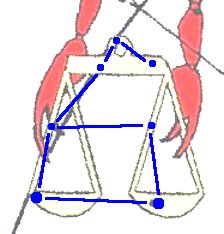 |
Fig. 4. My former Balance
An earlier article pointed out that there are seven constellations with seven stars, each with those stars in the shape of a square with three stars roughly in a straight line like the tail of a kite. The Balance was one of those seven.[10] Figure 4 shows the illustration of the Balance used in that article. It is seen that only one of the stars has been changed to create the form proposed in this article. That is, the end of the former kite tail is removed and replaced with the dimmest and lowest star in the handle. It is barely visible to a good eye on a dark night and previously seemed too dim to use. But it is bright enough to be listed by Ptolemy and is one of only three stars listed between the Claws. Thus it fulfills the criterion of the earlier article even better by forming a straight line.
2. The Scorpion
Now let us apply the same process to the Scorpion. Let us see if we can utilize the stars listed as outside of the Claws to incorporate into a scorpion image which is plausible and does not confuse the two figures. Figure 5 illustrates my best guess at the correct version of the constellations before the new version being proposed in this article. It illustrates five of the six stars which Ptolemy lists as outside the claws. The sixth is located well above the left claw and does not appear to be usable.
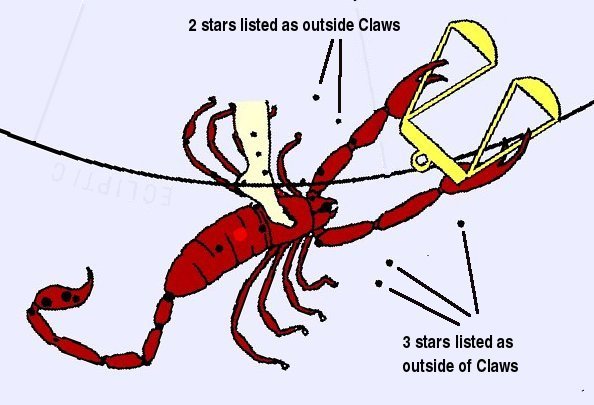 |
Fig. 5. My former Scorpion and Balance
Before discovering the key to which stars used to be in the Balance and former claws, it did not seem possible to use any of those stars, even though several of them are bright. Their brightness was a puzzle to me because the lower ones seemed to be in the area where the claws should be, but I felt obligated to follow Ptolemy's prohibition to include them. The result was that the claws in my former version were drawn without any bright stars in them. The Greeks remedied this problem by extending the claws all the way out to the two stars which are in the trays of the Balance. Thus it is not hard to see that the Greeks finally lost the Balance altogether. But my solution was not much better. While it avoided the confusion of images which the Greek model had, it suffered from the problem of no bright stars in the claws. In fact, there were no stars at all in the right claw. The constellations were meant to be seen, so I knew that it could not be exactly right but it was my best attempt twenty years ago. Now, finally we are at liberty to utilize the forbidden bright stars which indeed are in the area where claws should be.
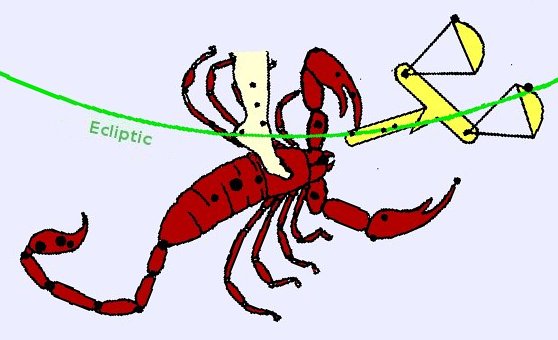 |
Fig. 6. New proposed Scorpion and Balance
Note in Figure 5 how far from the scorpion the uppermost extra star is. At first it seemed too high to use at all. Then photos of real scorpions were consulted and it was realized that the claws needed to be on forearms long enough to bring the long claws to the mouth for eating captured prey. That uppermost star could be used provided that the left claw was near the mouth. That put it right at the end of the handle of the Balance. Thus it was discovered that the Scorpion is holding the Balance in his left claw. Figure 6 illustrates the proposed restoration of the Scorpion holding the Balance in his left claw. Note that when creating the new version, the same claws (drawn by a real artist) were simply moved to be in the new positions. Note how perfectly they fit over the bright stars.
If that is indeed the original form of the Scorpion, it is easy to see how astronomers might change the stars forming the scorpion to be in a more natural position. Probably the first step was to put the Balance between the claws, which is how I have it shown in my earlier articles. The problem with that was that there were no stars in the claws that clearly showed their position. The next step would be to get rid of the Balance altogether because it didn't fit the pattern of the other constellations. It was the only non-living figure. So the claws were made even larger for the Greeks and the Balance disappeared.
 |
Fig. 7. A scorpion's flexible claws
Note how similar a photograph of a real scorpion, shown in Figure 7, is to the figure in the heavens. Both have two joints before the big claws which are arranged to give great flexibility of movement. The claws can bring food to the mouth and can easily be in the positions shown in the proposed figure. Until now, the body and tail of the Scorpion looked just like a real scorpion but one always needed to explain that something happened to the claws. Now we can have our cake and eat it too: the Scorpion has long and large claws like a real scorpion and yet the Balance is also totally visible. There is no longer a need to choose between them.
Why would the Scorpion be figured holding the Balance? In earlier articles it was proposed that the Scorpion has at least dual symbolism. On the one hand (left hand), it represents Satan, who is being crushed by the Serpent Bearer. On the other hand (right hand), it represents Christ as the Judge.[11] Scripturally a scorpion is a type of serpent and Christ was often represented by a serpent, such as the serpent which Moses raised on the staff.[12]
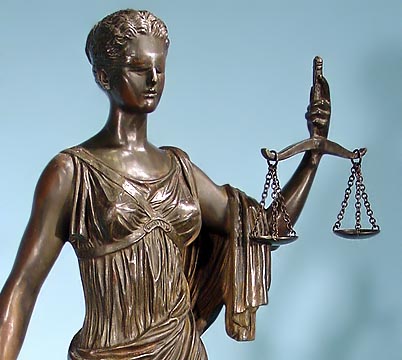 |
Fig. 8. Blindfolded Justice holds balance in left hand
Throughout history, "Justice" has been symbolized as a blindfolded person (usually a woman) holding a balance scale in the left hand as shown in Figure 8. The Scorpion also holds the Balance in the left Claw. Justice is also often shown with a sword in the right hand, representing the sword of justice.
The balance being used to judge mankind is also a scriptural image. As the writing on the wall read by Daniel said of the king, "Thou art weighed in the balances, and art found wanting." (Dan. 5:27). May that not be said of us on Judgment Day.
Following the lead of many earlier researchers, it has been proposed in my articles that Libra symbolized the role of Christ as the Redeemer who would pay the price of redeeming the souls of mankind. In that symbolism, the Balance is not shown balanced but instead with the side representing Christ's payment as lower, having more than paid the price of all sin. As seen from the Scorpion's point of view, Christ is on the right side and mankind who is found wanting is on the left. The concept also fits well with the Persian version where the person holding the scales is also holding a lamb, which could represent the Lamb of God who paid the price.
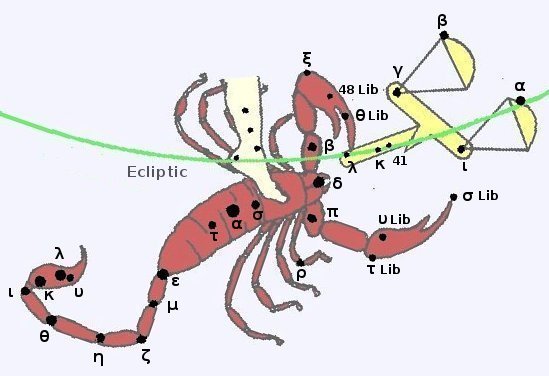 |
Fig. 9. Modern star designations
Figure 9 indicates the modern star designations of all of the stars in the two constellations. The three stars listed by Ptolemy as between the claws are Lambda (λ) Lib, Kappa (κ) Lib, and 41 Lib. It is important to note that these are not three bright stars. All three are fifth magnitude, meaning barely visible. There are many brighter stars in the neighborhood which are omitted from Ptolemy's list. But these three just happen to make a perfectly straight handle along the ecliptic. This is fairly compelling circumstantial evidence that these three stars did indeed form a handle.
The modern designations of the five stars added to the Scorpion are Xi (ξ) Sco, 48 Lib, Sigma (σ) Lib, Tau (τ) Lib, and Upsilon (υ) Lib. Note that the star Lambda (λ) Lib is to be considered as being shared both as the tip of the left claw of the Scorpion and also the end of the handle of the Balance. Many stars are found in two constellations as it often helps to show the relationship between them. In this case, from a simple list of stars and their positions in the figures, such as that given by Ptolemy, it would be clear that the Scorpion is holding the Balance.
3. Conclusion
Earlier papers showed that the key to restoring ancient constellations to their original form is often found in utilizing stars which are listed in Ptolemy's star catalog as being near but not included in the figure. The Balance (Libra) was entirely lost to the Greeks who only saw the Claws of the Scorpion in that place. Using eight of the nine stars listed as near the Claws, the proposed restorations of both the Balance and the Scorpion are presented. The form of the Balance matches ancient depictions of a hand-held balance. Moreover, utilization of the stars near the Scorpion implies that his left claw is holding the Balance. Earlier papers identified one interpretation of the Scorpion as Christ in his role as Judge, so this restoration with Him meting out justice with a balance becomes yet another witness to the constellations typifying the gospel and mission of the Savior Jesus Christ.
Notes
- Pratt, John P., "The Forgotten Left Stream of Aquarius" (9 Jan 2016) summarizes the ideas and sources and attempts to restore the missing left stream of the constellation of the Water Bearer (Aquarius).
Pratt, John P., "The Ptolemy Star Catalog" (14 Dec 2015) which has a link to download Ptolemy's entire star catalog of 1,025 stars.
Allen, Richard, Star Names, Their Lore and Meaning (New York: Dover, 1963, reprinted from 1899), p. 271.
Allen, op. cit., p. 273.
Pratt, John P., "Answering Objections to Gospel in the Stars" (10 July 2004), Question 14.
Description de l'Egypt (Paris: Commission des sciences et arts d'Egypt, 1809-1828). This illustration is from a photocopy made at the U. of Utah nearly fifty years ago. It is gratifying that it is finally being used.
Pratt, John P., "Albumazar's 48 Constellations" reproduces all of the Latin descriptions and illustrations from that volume.
Allen, op. cit., p. 273.
Allen, op. cit., p. 275-6.
Pratt, John P., "Super Constellation Testifies of Unified Design" (10 Oct 2015), Section 2.7 "The Balance (Libra)".
Pratt, John P., "The Zodiac Testifies of Christ" Meridian Magazine (15 Jun 2005), Section 4.1 "The Judge".
Millett, Ronald P. & Pratt, John P., "What Fiery Flying Serpent Symbolized Christ?" Meridian Magazine (9 Jun 2000) attempts to identify just what kind of serpent Moses lifted onto the staff.










